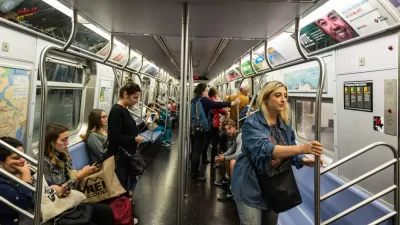SHANGHAI, CHINA--I've been a fan of New Urbanism for several years, but I've always considered myself an urban "pluralist"--someone who doesn't believe there is an "objective" or general urban form that is persistently successful over long periods of time. Indeed, Bob Bruegmann's thesis in Sprawl: A Compact History, suggests that urban form changes and evolves over time, although generally in a less dense direction.
SHANGHAI, CHINA--I've been a fan of New Urbanism for several years, but I've always considered myself an urban "pluralist"--someone who doesn't believe there is an "objective" or general urban form that is persistently successful over long periods of time. Indeed, Bob Bruegmann's thesis in Sprawl: A Compact History, suggests that urban form changes and evolves over time, although generally in a less dense direction.
The test of this thesis is being put to the test in China. We've visited three cities so far, and all of them are busting out at the seems. The trend is toward more density, larger scale, more modernist structures and contemporary architecture. In fact, China's major cities are a New Urbanist's nightmare.
All one has to do is look at the towering residential apartment and commercial office buildings going up all over Beijing, in the older neighborhoods of Chengdu, and in Shanghai, to raise fundamental questions about the sustainability of any specific urban form. I may prefer the small, homey feel of small town America, but the post-modern city building evident all across these cities in China suggests a level and pace of urbanism that we haven't seen on this side of the ocean since the late 19th century.
Of course, one could argue that China's urban form reflects its urban character. New York, Chicago, Boston, San Francisco and other cities experienced high rise land development during their periods of rapid growth. It could be that rising incomes will lead to the same trends Bob Bruegmann has observed for almost all other cities.
If that's true, then China will have to grapple with a level of sprawl that no nation in the world has yet come to grips with. Adopting a "human scale" development pattern on a megacity of 20 million (Shanghai), 16 million (Beijing), or Chengdu (10 million) means the boundaries of these cities will expand exponentially.
If China's cities continue to densify, as Hong Kong has done, then the challenge for many planners in the New Urbanist tradition will have to come to grips with the apparent sustainability of post-modernist cities where scale is completely out of proportion to anything remotely considered "human" scale. T6 in the transect just doesn't cut it, particularly when the city skips T4,T3, and T2.
I remain strong in my belief that New Urbanist design is crucial to the ongoing evolution of our suburbs, and the revitalization of our urban centers. But, it's always useful to have an outside the box reality check. And China's urbanism is doing just that.

Alabama: Trump Terminates Settlements for Black Communities Harmed By Raw Sewage
Trump deemed the landmark civil rights agreement “illegal DEI and environmental justice policy.”

Study: Maui’s Plan to Convert Vacation Rentals to Long-Term Housing Could Cause Nearly $1 Billion Economic Loss
The plan would reduce visitor accommodation by 25% resulting in 1,900 jobs lost.

Planetizen Federal Action Tracker
A weekly monitor of how Trump’s orders and actions are impacting planners and planning in America.

Wind Energy on the Rise Despite Federal Policy Reversal
The Trump administration is revoking federal support for renewable energy, but demand for new projects continues unabated.

Passengers Flock to Caltrain After Electrification
The new electric trains are running faster and more reliably, leading to strong ridership growth on the Bay Area rail system.

Texas Churches Rally Behind ‘Yes in God’s Back Yard’ Legislation
Religious leaders want the state to reduce zoning regulations to streamline leasing church-owned land to housing developers.
Urban Design for Planners 1: Software Tools
This six-course series explores essential urban design concepts using open source software and equips planners with the tools they need to participate fully in the urban design process.
Planning for Universal Design
Learn the tools for implementing Universal Design in planning regulations.
Caltrans
Smith Gee Studio
Institute for Housing and Urban Development Studies (IHS)
City of Grandview
Harvard GSD Executive Education
Toledo-Lucas County Plan Commissions
Salt Lake City
NYU Wagner Graduate School of Public Service





























